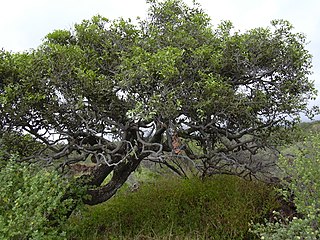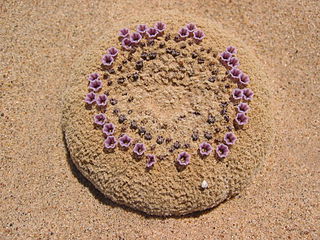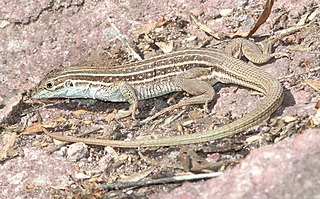
The persimmon is the edible fruit of a number of species of trees in the genus Diospyros. The most widely cultivated of these is the kaki persimmon, Diospyros kaki – Diospyros is in the family Ebenaceae, and a number of non-persimmon species of the genus are grown for ebony timber. In 2019, China produced 75% of the world total of persimmons.

The Ebenaceae are a family of flowering plants belonging to order Ericales. The family includes ebony and persimmon among about 768 species of trees and shrubs. It is distributed across the tropical and warmer temperate regions of the world. It is most diverse in the rainforests of Malesia, India, tropical Africa and tropical America.

The genus Pholisma consists of three to five species of desert-dwelling, primarily subterranean plants.

Diospyros is a genus of over 700 species of deciduous and evergreen trees and shrubs. The majority are native to the tropics, with only a few species extending into temperate regions. Individual species valued for their hard, heavy, dark timber, are commonly known as ebony trees, while others are valued for their fruit and known as persimmon trees. Some are useful as ornamentals and many are of local ecological importance. Species of this genus are generally dioecious, with separate male and female plants.

Sapote is a term for a soft, edible fruit. The word is incorporated into the common names of several unrelated fruit-bearing plants native to southern Mexico, Central America and northern parts of South America. It is also known in Caribbean English as soapapple.

Pholisma sonorae, commonly known as sandfood, is a rare and unusual species of flowering plant endemic to the Sonoran Deserts to the west of Yuma, Arizona in the California Yuha, Mojave Desert and Colorado Desert, and south in the Yuma Desert, where it is known from only a few locations.

Diospyros melanoxylon, the Coromandel ebony or East Indian ebony, is a species of flowering tree in the family Ebenaceae native to India and Sri Lanka; it has a hard, dry bark. Its common name derives from Coromandel, the coast of southeastern India. Locally it is known as temburini or by its Hindi name tendu. In Odisha, Jharkhand, and Assam, it is known as kendu. In Andhra Pradesh, and Telangana it is known as tuniki. The leaves can be wrapped around tobacco to create the Indian beedi, which has outsold conventional cigarettes in India. The olive-green fruit of the tree is edible.
Black persimmon can refer to two dark-fruited species of the persimmon and ebony genus Diospyros:

Diospyros blancoi,, commonly known as velvet apple, velvet persimmon, kamagong, or mabolo tree, is a tree of the genus Diospyros of ebony trees and persimmons. It produces edible fruit with a fine, velvety, reddish-brown fur-like covering. The fruit has a soft, creamy, pink flesh, with a taste and aroma comparable to peaches.

Lennooideae is a subfamily of parasitic flowering plants of southwestern North America and northwestern South America.

Psittacanthus, also parrot-flower, is a plant genus in the family Loranthaceae. It is a type of mistletoe native from central Mexico southwards to Central America and parts of South America.
Eriogonum deserticola is a species of wild buckwheat known by the common name Colorado Desert buckwheat.

Diospyros texana is a species of persimmon that is native to central, south and west Texas and southwest Oklahoma in the United States, and eastern Chihuahua, Coahuila, Nuevo León, and Tamaulipas in northeastern Mexico. Common names include Texas persimmon, Mexican persimmon and the more ambiguous "black persimmon". It is known in Spanish as chapote, chapote manzano, or chapote prieto, all of which are derived from the Nahuatl word tzapotl. That word also refers to several other fruit-bearing trees.
Fleischmannia sonorae, the Sonoran slender-thoroughwort or Sonoran thoroughwort, is a North American species of flowering plant in the family Asteraceae. It is native to western Mexico from Sonora and Chihuahua as far south as Michoacán, as well as from the southwestern United States.

The Sonoran spotted whiptail is a parthenogenic species of teiid lizard found in Arizona and New Mexico in the United States, and Mexico.
Briquetia is a genus of flowering plants belonging to the family Malvaceae.
Dayia is a genus of flowering plants belonging to the family Polemoniaceae.

Ibervillea is a genus of flowering plants belonging to the family Cucurbitaceae.

Ibervillea sonorae is a tuberous perennial plant in the Cucurbitaceae family known by the common names wereke, wareque, guarequi, and coyote melon. It is a highly variable species characterized by a large, succulent tuberous root, which in the dry sand of its native habitat resembles a gray, dust-covered boulder. Emerging from the root yearly are long, flexible liana-like shoots, which reach a length of three or more meters. This species is native to northwestern Mexico, being found in the states of Baja California, Baja California Sur, Sonora and Sinaloa.












